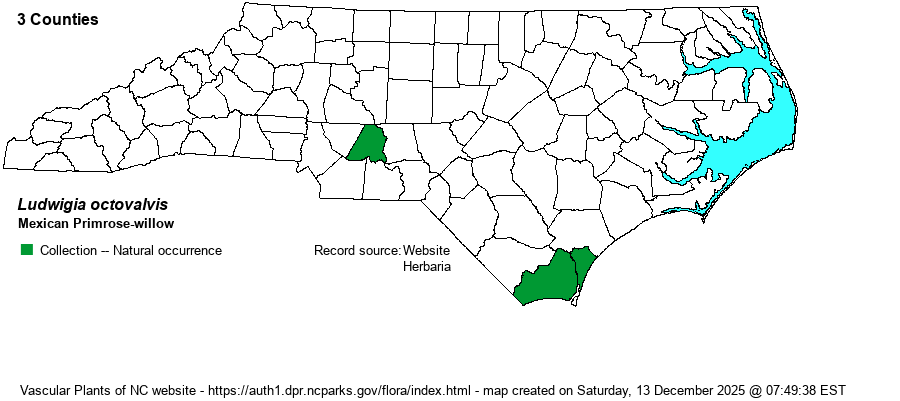| Author | (Jacquin) Raven | |
| Distribution | A relatively tiny range in the state, essentially only along the Cape Fear River and Brunswick River in the vicinity of Wilmington. Apparently not known farther west in Brunswick County, nor farther to the north either. In 2020 a specimen from Stanly County originally identified as L. hexapetala (Sorrie 11997 NCU) was annotated to L. octovalvis.
This is a species of the Deep South, found sparingly north to extreme southeastern NC, and south to the Gulf Coast, and much farther into the tropics. There is some confusion between this species and the non-native L. bonariensis in the literature. In fact, RAB (1968) had records for L. octovalvis included within L. bonariensis. Note, however, that Wikipedia says "its native distribution is unclear", and there is probably not unanimity that it is native as far north as NC.
| |
| Abundance | This species appears to be widespread in the small area of Eagles Island and adjacent areas. The NCNHP has given a State Rank of S2?, but removed it from its Watch List in 2022. | |
| Habitat | This is a species of the extensive tidal freshwater marshes in the Cape Fear/Brunswick River region just west and northwest of Wilmington. It also grows in damp disturbed ground in this area. In Stanly County, it grows in a beaver pond that lies in an old meander of the Pee Dee River. | |
| Phenology | Blooms from May to September, and fruits shortly after flowering. | |
| Identification | This is a very tall and robust species, growing as high as 5-6 feet tall. The stem is generally smooth, much branched, and with alternate leaves. The leaves are variable, but mostly quite narrow, lanceolate to narrowly elliptic, to about 6 inches long but only 1/2-inch wide at best. The flowers, in leaf axils, are the largest of the native Ludwigia species, with the 4 bright yellow and rounded petals each about 3/4-inch long, meaning the spread flower is often about 1.5 inches across. The floral tubes and capsules are quite long, up to 1-inch but narrow. Note that the non-native L. bonariensis has been collected in the state a few times, but SERNEC records from the Wilmington area probably are of L. octovalvis. That exotic has much larger yellow flowers, each petal about 1.5 inches across and a full spread flower about 3 inches across, and its sepals are about 10 mm (2/5-inch) wide at the base, versus sepals only 3-5 mm (1/6-inch) wide at the base in the native species. This species should be reasonably obvious to biologists in the Cape Fear River area near Wilmington, as it is a conspicuous species of marsh edges owing to its tall size and large yellow 4-petalled flowers. | |
| Taxonomic Comments | As mentioned above, there has been confusion in NC between this native species and the non-native L .bonariensis. Most or nearly all recent references do have this confusion "sorted out", though the provenance of L. octovalvis as far north as NC might still be unsettled.
| |
| Other Common Name(s) | Longfruit Primrose-willow | |
| State Rank | S2? [S2] | |
| Global Rank | G5 | |
| State Status | | |
| US Status | | |
| USACE-agcp | OBL link |
| USACE-emp | OBL link |

